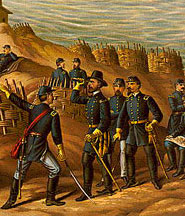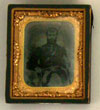
| A. Title: The Siege of Vicksburg |
||||||||||||||||||||||
Brandy Campbell, Social Studies Teacher, Utica Elementary/Middle School, Utica, MS (Grades 7-8) |
||||||||||||||||||||||
| B. Overview of this Collection-Based Lesson Unit Plan |
||||||||||||||||||||||
|
||||||||||||||||||||||
| C. Museum Collections, Similar Items and other Materials Used in this
Lesson Unit Plan |
||||||||||||||||||||||
|
||||||||||||||||||||||
| D. National Educational Standards |
||||||||||||||||||||||
| Era 5- Civil War and Reconstruction (1850-1877) Standard 2- The course and character of the Civil War and its effects on the American people. [Back to top] |
||||||||||||||||||||||
| E. Student Learning Objectives |
||||||||||||||||||||||
|
||||||||||||||||||||||
| F. Background and Historical Context |
||||||||||||||||||||||
In the spring of 1862, the importance of Vicksburg was realized by both the North and the South. The South realized that as long as it held Vicksburg the Mississippi River would be useless to Union traffic on the river and the railroads which run east-west would still be able to hold both sides of the Confederacy intact. President Abraham Lincoln said, “See what a lot of land these fellows, hold, of which Vicksburg is the Key.” Williams’ Canal Milliken’s Bend (Duckport Canal) The Yazoo Pass The route by Steele’s Bayou The Siege As the siege began there were efforts by the Confederates on the Louisiana side of the river to relieve the pressure felt in Vicksburg, but to no avail. Pemberton’s only hope of getting out of the siege rested on the shoulders of General Joseph Johnston. Johnston had hinted at a possible joint attack. Johnston would proceed from Jackson, MS, toward Vicksburg, thus trapping the Union Army in between the Confederate forces. Johnston really never had any intention of carrying out this plan. Effects of Siege Final Outcome |
||||||||||||||||||||||
| G. Vocabulary |
||||||||||||||||||||||
Batteries- Placements of artillery (soldiers and weapons) |
||||||||||||||||||||||
| H. Teacher Tips |
||||||||||||||||||||||
|
||||||||||||||||||||||
| I. Lesson Implementation Procedures |
||||||||||||||||||||||
Lesson One: Importance of Taking Vicksburg Warm up- Journaling activity (suggested time 15-20 minutes) Informative Session (suggested time 20-30 minutes) Vocabulary (suggested time end of class) Mapping Activity (suggested time 15-20 minutes) Lesson Three: Understanding Civilian Life Visuals (suggestive time 20-30 minutes)Students will view selected items from the Vicksburg National Military Park Museum Collection. Discuss and explain how these items were used by civilians and affected them. Assessment (remainder of class period/homework) Introduction activity (suggested time 10-15 minutes) Overview (suggested time 5-10 minutes) Informative session (suggested time 15-20 minutes) Assessment - (suggested time end of class) |
||||||||||||||||||||||
| J. Evaluation/Assessment for Measurable Results |
||||||||||||||||||||||
Rubrics:
|
||||||||||||||||||||||
| K. Extension and Enrichment Activities |
||||||||||||||||||||||
|
Geography Teacher will provide students with a blank map of the United States and will label and color the following:
Letter Writing Lesson (55 minutes) Teachers will read letters from the museum collection to the students. The students will take on roles of people during The Siege. They are to write their own letters. The girls will be writing letters to their “soldiers and family” portraying citizens of Vicksburg. The boys will be writing letters to their “sweethearts and family” about the role they played during the siege. The boys can pick whether they would like to be Confederate or Union soldiers. After the students have completed their letters, they will present them to the class. |
||||||||||||||||||||||
| L. Resources |
||||||||||||||||||||||
Michael B. Ballard, The Campaign for Vicksburg Civil War Series Eastern National Standard, 2007 |
||||||||||||||||||||||
| M. Site Visit |
||||||||||||||||||||||
| Visit the Vicksburg National Military Park virtual exhibit at http://www.nps.gov/museum/exhibits/vick/index.html, and the park in Vicksburg, MS. [Back to top] |
||||||||||||||||||||||








